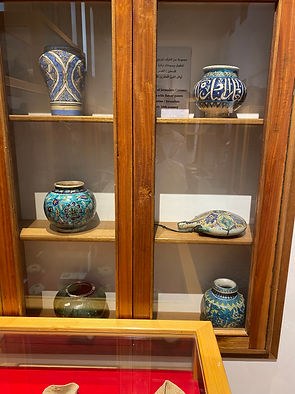
Sheikh Faisal's Museum
Palestine Room
The project I worked on the most was for the Palestinian room at the museum. For this, I had to do research on not only the Palestinian embroidery, but also the oil lamps and al-Nakbha in order to get the most up-to-date information on it. When the research was done, I got to write a museum text for both the Palestinian embroidery and the oil lamps. When I was writing everything out, I also included all my research down below with the sources so that way the museum staff would have access to everything I found out once I had left the museum. And with this project, I had to work closely with the curator and director so that way I could see what direction they wanted the research to go in, and then what the writing needed to look like. The tone was the most difficult part of the writing because I had to be very neutral about the Palestinian embroidery and al-Nakba, even though it wasn't a neutral topic. So, I was able to do it. I just had to be careful with what I was saying, so I wasn't overall favouring one side, and balancing the emotions in the text.

Database
Another big project I got to help work on was with the museum’s database called MuseumSense. Here I got to add artefacts that the museum had to the database. This included adding the accession number, where they're located, their description and then any measurements that were taken. During this time, I added 8,000 to 10,000 different artefacts and I also added descriptions to a large portion of them. Most of the collections were from the fossil section of the museum, as that was what they needed help with at that time. I also got to help identify some groupings of fossils themselves, and find the Latin names for them. While I did the preliminary work, another staff member at the museum also overlooked my work at a later point to ensure that I was putting the right names to the fossils and not misidentifying any of them. For the database as well, I also got to help upload photos to the artefacts. For this job, I had to get receive all the photos in batches and then organise them based on the accession number of the artefact. From there I would share them with the curator, who would then use the museum system to upload everything onto the database at once.
Tours
Another project I helped with was when the Georgian Prime Minister came to visit the museum. On the day the Prime Minister was arriving, I helped with any last-minute adjustments that the team needed assistance with. When the Prime Minister came, it was after hours, and I got to help answer any questions that the group had. During this time too, the Sheikh who owns the museum was also there to actually give the tour, while the museum staff assisted when needed. If there are any questions that I was not sure of the answer to, I would then guide them to one of the other museum staff who would better know the answer. That way, I was not giving the person the wrong information. Throughout this time, the Sheikh was showing the group the rooms that aren't accessible to the public and have to be opened by him. So, I not only got to see artefacts I never see otherwise, I got to assist in any way that the staff and group needed. I would also help make sure that no member of the group was lost, as I usually stayed in the back to make sure nobody was being left behind.
General Duties
Well, while all of these projects were happening, I was attending meetings and helping in any other way that the museum needed. I had to attend monthly meetings where I would share with the team my progress so far and hear what everyone else was doing. In the second meeting I attended, I also had to take notes as the person who normally did it wasn't there at that time. These meetings included team-building exercises which I participated in. After the second meeting, I also shared my notes with the team in case they wanted them for future reference. Even with my own projects, I would have meetings with the curator, conservator, and director, so in that way, we could share the same vision and goals for what I was doing in my internship so far. Additionally, I also went with the assistant curator to return some artefacts to the Syrian embassy to see what types of things curators get to do in the field. I also got to make a new connection for myself, while noticing how the museum gets to maintain its connections to embassies. I also assisted the museum in the layout of some artefacts and see where things might best fit – some of which are still laid out like that today. I also got to assist the conservator with their data on temperature and humidity, so that way everything was where it was meant to be according to the guidelines.

Museum Newsletter

To learn more about the museum, click here.




